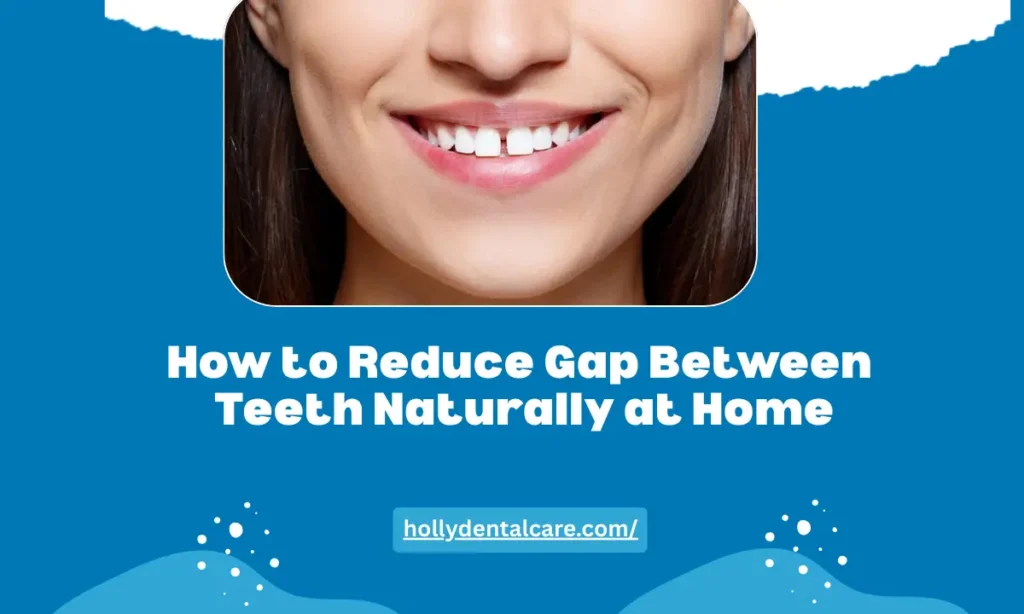Many of us undoubtedly have little quirks in our smile. A slightly crooked tooth, an overbite, or a tiny gap between our teeth. Moreover, for some people those gaps (also known as diastema) are part of their charm. But, for others, it might be something they’d prefer to change. If you fall into the second group. Then, you may have wondered: “Can I close this gap at home without braces or expensive dental work?” Here, the answer is yes, to a certain extent. Especially if the gap is small. Natural remedies and simple habits can reportedly make a difference over time. While they won’t work overnight or replace professional orthodontic care for more serious cases. However, they can help reduce or prevent further spacing.
Overview: How to Reduce Gap Between Teeth Naturally at Home
Before trying to fix anything. Here, it’s important to know why it’s happening in the first place. As per the reports, gaps in teeth can be caused by:
- Genetics: Here, it might just run in your family.
- Moreover, childhood habits like thumb-sucking or tongue-thrusting.
- Further, missing teeth or teeth that are smaller than average.
- Gum disease, which can furthermore cause bone loss and shifting.
- Additionally, a tight or oversized labial frenulum. Here, it’s a tissue between your upper lip and front teeth.
If your gaps are reportedly the result of gum disease or a structural issue. Then, it’s best to talk to a dentist first. But if it’s a minor gap or simply cosmetic. Thus, natural solutions might help.
Natural Ways to Reduce Teeth Gaps at Home
Dental Bands (With Caution)
According to the sources, some people use tiny orthodontic bands. So, it can close small gaps between front teeth. Gradually, these are tiny rubber bands that pull your teeth closer together.
- Here, you wear the band around the two teeth with a gap. For at least a few hours daily.
- Moreover, it’s a DIY method some claim works over a few weeks.
Caution: These bands can reportedly cause damage if not used properly. Therefore, always speak to a dental professional first. Because if the band slips under your gums, then it can cause permanent harm.
Improve Tongue Posture (Mewing)
At first, this might sound strange. But how you rest your tongue in your mouth can actually affect your jaw and teeth alignment. Especially in younger people.
- First, try to rest the entire tongue against the roof of your mouth.
- Then, keep lips sealed and teeth lightly touching when relaxed.
- Moreover, practice this consistently during the day.
This technique are reportedly known as mewing. Here, it may help influence tooth position subtly over time. While results are unfortunately slow and often debated. But it’s a healthy habit that encourages proper oral posture.
Oil Pulling for Gum Support
According to the reports, oil pulling won’t physically move your teeth. However, it’s a simple, natural way to boost gum health. Hence, it can help prevent shifting and tooth movement. That was caused by gum disease.
- First, swish a tablespoon of coconut or sesame oil in your mouth. At Least for 15–20 minutes.
- Then, spit it out (never swallow).
- Now, rinse, and brush your teeth.
- Here, do this daily for best results.
- Strong, healthy gums are definitely key to keeping your teeth in place.
Oral Exercises
These exercises unfortunately won’t replace braces. But it may help tone the muscles around your mouth. Also, encourage better alignment.
- First, tap your upper and lower front teeth gently together 20 times.
- Then, repeat a few times a day.
- Also, bite softly on a clean pencil held horizontally. Especially for a minute or two.
It’s like physical therapy, but for your teeth. Moreover, small habits like this might not close a gap entirely. However, they promote muscle memory and oral awareness.
Eat Foods That Support Strong Teeth and Gums
What you eat affects every part of your body. Including your smile. Then, to support strong teeth and tight gums:
- Here, eat calcium-rich foods: dairy, leafy greens, almonds.
- Moreover, get enough Vitamin C from fruits. Like oranges and kiwi to support gum health.
- Include magnesium and Vitamin D for better calcium absorption.
These unfortunately won’t close a gap. But they help create the right environment. Especially for your teeth to stay firmly in place.
Avoid Habits That Make Gaps Worse
Sometimes the best “treatment” is simply stopping. Especially what’s causing the problem in the first place.
- Tongue thrusting (pushing your tongue against your front teeth when you swallow).
- Moreover, thumb-sucking (in children).
- Further, using your teeth as tools (opening bottles or tearing packages).
- Furthermore, neglecting gum care. As a result, it can lead to periodontal issues.
- In addition, breaking these habits is key to maintaining improvements over time.
Try Clear Aligners (If DIY Kits Are an Option)
Although not entirely “natural,” some at-home aligner kits are affordable. Also, supervised by professionals virtually. These are reportedly more gentle than traditional braces. Further, they can correct minor spacing issues within months.
Moreover, be careful to choose a reputable company. Also, make sure your case is reviewed by a licensed dentist. Unfortunately, not all gaps can be fixed this way. But it’s worth exploring if you’re open to a more structured option. Especially without going to the clinic regularly.
When to Seek Professional Help
While the above methods can definitely help with very small or emerging gaps. However, professional dental advice is necessary in certain scenarios:
- Large or multiple gaps
- Associated pain or bleeding gums
- Loose teeth
- Jaw alignment issues
- Speech difficulties
Moreover, a dentist may suggest many options. Such as bonding, braces, clear aligners, or veneers. Or frenectomy surgery depending on the condition.
So… Can You Really Close Gaps Without Braces?
If the gap is reportedly small, recent, or caused by minor habits. Then yes, natural methods might help over time. Moreover, things like tongue posture, oil pulling, oral exercises, and healthy habits can make a real difference. However, it takes patience, consistency, and understanding. That these are slow, subtle fixes, not quick miracles. On the other hand, if the gap is unfortunately large. Here, it’s caused by a structural or genetic issue, or tied to gum disease. Then, a dental professional is your best bet.
Final Thoughts
Nowadays, there’s nothing wrong with having a little space in your smile. Here, it’s part of what makes you you. However, if it’s something you’d like to change. Then, natural methods can be a great first step. They’re reportedly gentle, affordable, and good for your overall dental health. Even if they don’t completely close the gap.
Also read:- Teeth Cleaning Cost: Price Breakdown, Benefits & Facts



